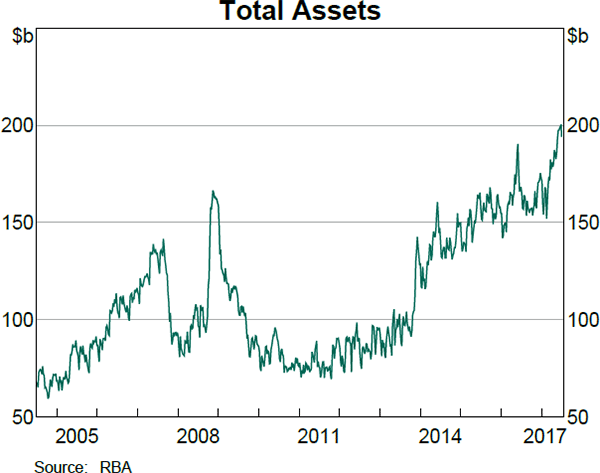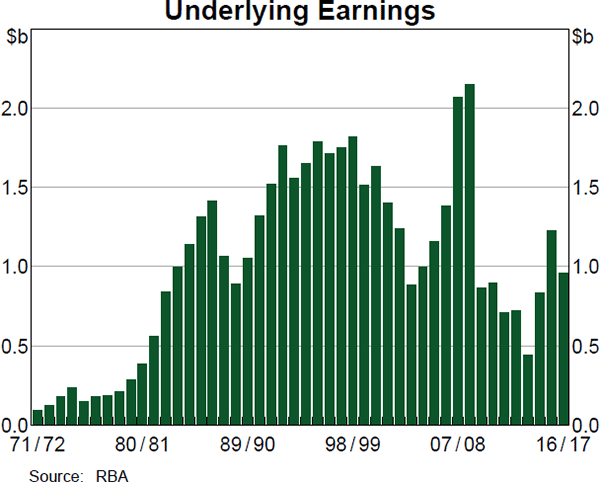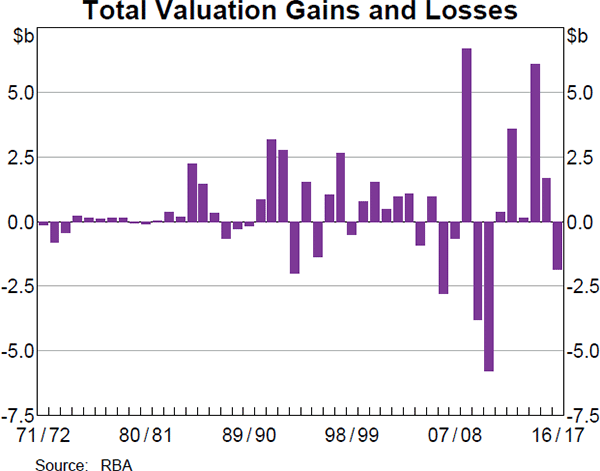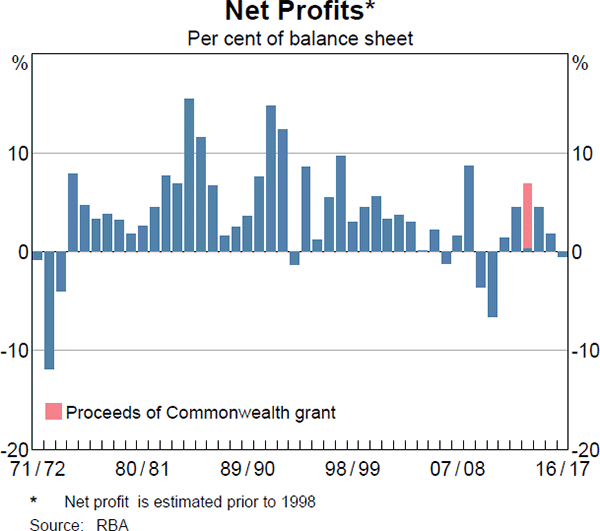Reserve Bank of Australia Annual Report – 2017 Earnings, Distribution and Capital
While the Reserve Bank earns a profit in most years, it also holds reserves sufficient to cover potential financial losses when they occur. In 2016/17, the Bank recorded an accounting loss of $0.9 billion, as unrealised valuation losses exceeded the sum of other components of profit. Despite the accounting loss, earnings of $1.3 billion were still available for distribution as, when determining distribution under the Reserve Bank Act 1959, unrealised valuation losses are offset against previously retained net unrealised valuation gains.
The Reserve Bank's Balance Sheet
The Reserve Bank holds a range of financial assets to pursue its monetary policy objectives and support an efficient and orderly payments system in Australia. The Bank also manages Australia's portfolio of international reserves. The portfolio of domestic securities is used to conduct market operations and manage liquidity in the cash market in Australia. The domestic portfolio is composed mainly of repurchase agreements, although the Bank also holds outright some domestic securities issued by the Australian government and state and territory borrowing authorities. Operations in the foreign exchange markets are primarily undertaken either on behalf of customers or to manage the foreign reserves. When appropriate, foreign exchange swaps are also undertaken to assist domestic liquidity management operations. The Bank's liabilities mainly comprise banknotes on issue, deposits of the Australian Government and other customers, and capital and reserves. See the chapter on ‘Operations in Financial Markets’ for further details.
The Reserve Bank's balance sheet was $194 billion on 30 June 2017, compared with $167 billion a year earlier. Banknotes on issue, the Reserve Bank's single largest liability, rose by about 5 per cent, to $74 billion, while deposits of the Australian Government rose by about $28 billion. Management of the Bank's assets is discussed in the chapter on ‘Operations in Financial Markets’; the associated risks are considered in the chapter on ‘Risk Management’.

The Reserve Bank's Earnings
The Reserve Bank's earnings arise from two sources: underlying earnings – comprising net interest and fee income, less operating costs – and valuation gains or losses. Net interest income arises because the Bank earns interest on almost all of its assets, albeit currently at low rates, while it pays no interest on a large portion of its liabilities, such as banknotes on issue and capital and reserves. Fees paid by authorised deposit-taking institutions associated with the Committed Liquidity Facility also make a significant contribution to underlying earnings.
Valuation gains and losses result from fluctuations in the value of the Reserve Bank's assets in response to movements in exchange rates or in yields on securities. A depreciation of the Australian dollar or a decline in interest rates results in valuation gains. Conversely, an appreciation of the Australian dollar or a rise in market yields leads to valuation losses. These gains and losses are realised only when the underlying asset is sold or matures. Valuation gains and losses are volatile from year to year, as both exchange rates and market interest rates fluctuate in wide ranges over time. Market risk is managed by the Bank within strict parameters determined by its responsibility for monetary policy.
The Reserve Bank reports net profit as income from all sources, in accordance with Australian Accounting Standards, while the distribution of profits is determined by section 30 of the Reserve Bank Act. In terms of the Reserve Bank Act, net profit is distributed in the following way:
- Unrealised gains (or losses) are not available for distribution and are transferred to (absorbed by) the unrealised profits reserve. The remainder of net profit after this transfer is available for distribution.
- The Treasurer then determines, after consultation with the Reserve Bank Board, any amounts to be placed from distributable earnings to the credit of the Reserve Bank Reserve Fund (RBRF), the Bank's permanent reserve.
- The remainder of distributable earnings after any transfer to the RBRF is payable as a dividend to the Commonwealth.
The composition of the Reserve Bank's net profit in 2016/17 is summarised in the table below.
| Underlying earnings | 960 |
|---|---|
| Net unrealised valuation loss (–) | −2,179 |
| Net realised gain | 322 |
| Net loss | −897 |
|
Source: RBA |
|
In 2016/17, the Reserve Bank's underlying earnings were $960 million, which was $263 million lower than the previous year because of lower net interest income resulting from a decline in the net interest margin. The reduced interest margin reflected, in part, the decline in short-term interest rates in Australia compared with the previous year. Underlying earnings remained at historically low levels with interest rates around the world also typically remaining low.
The Reserve Bank's underlying earnings were offset by net valuation losses of $1,857 million, primarily from the appreciation of the Australian dollar during the year. The net valuation loss was composed of an unrealised valuation loss of $2,179 million offset by net realised gains of $322 million, largely as a result of the sale of foreign currency in the normal course of managing the portfolio of foreign reserves; these transactions had no effect on the value of the Australian dollar. The realised gains came from sales of assets on which unrealised gains had been recorded in earlier years, and therefore they acted to deplete the balance of the unrealised profits reserve, as discussed further below.


The net outcome was that the Reserve Bank recorded an accounting loss of $897 million, or 0.5 per cent of the balance sheet, in 2016/17. The pattern of net profit over the longer term is shown in the graph on net profits below.
Despite the accounting loss in 2016/17, earnings were still available for distribution, as the net unrealised valuation loss of $2,179 million was absorbed by the unrealised profits reserve in accordance with the Reserve Bank Act as explained above. This left earnings available for distribution amounting to $1,286 million in 2016/17, compared with $4,612 million in the previous year, reflecting both lower underlying earnings and smaller realised gains.

Capital, Reserves and Distribution
The RBRF is the Reserve Bank's general reserve and is the main component of the Bank's capital. The RBRF is funded from transfers from earnings available for distribution. Its purpose is to provide the capacity to absorb losses when it is necessary to do so.
The Reserve Bank Board has for many years had a policy of aiming to hold sufficient funds in the RBRF to absorb losses that might reasonably be anticipated from time to time. The RBRF served this purpose in 2009/10 and 2010/11 when the valuation losses from the large appreciation of the exchange rate in those years sharply depleted the Bank's reserves. These reserves have been restored over recent years, particularly as a result of a government grant in 2013/14.
During 2016/17, the Reserve Bank Board initiated a review of the capital framework to ensure that changes over time in the target balance in the RBRF appropriately reflected changes in the underlying risks faced by the Bank. The framework had previously required the same amount of capital to be held against all ‘at risk’ assets, regardless of their risk characteristics. This framework had been appropriate when the composition of the Bank's assets was relatively constant over time. However, over recent years, growth in the Bank's assets has been concentrated in low-risk, short-term domestic assets, rather than in higher-risk foreign exchange assets. As a result of the review, the Board has adopted a revised approach in which the Board's target for the RBRF is determined by assessing, and appropriately assigning capital to, exposures of different risk.

The largest potential for loss from the Reserve Bank's assets comes from market risk, comprising foreign exchange and interest rate risk. The capital assigned to each component of market risk has been derived from judgements based on the Bank's historical experience of loss and stress tests of the balance sheet, which incorporated significant adverse movements in the exchange rate and interest rates drawn from historical experience. Since the largest potential for loss is associated with the Bank's unhedged holdings of foreign exchange assets, materially more capital is assigned to exchange rate risk than to interest rate risk.
While the Reserve Bank has no history of loss from credit risk, credit risk has also been incorporated into the capital framework. In practice, the capital held against credit risk for assets held in the domestic portfolio and as part of international reserves is currently a small sum. This reflects the quality of assets the Bank holds, the soundness of counterparties with which it deals, the fact that repurchase agreements and foreign exchange swaps are well collateralised and that it follows a set of very conservative policies for managing credit risk, consistent with its very low appetite for such risk. Capital, therefore, is held only against the Bank's very small uncollateralised exposures to commercial banks. This overall approach to credit risk is consistent with the practice of a range of major central banks.
The Reserve Bank Board's capital framework will continue to be reviewed from time to time, including in response to developments that suggest the risk environment may be changing in material ways.
Based on the revised capital framework, the current balance in the RBRF met the Reserve Bank Board's target at the end of 2016/17. Accordingly, the Board views the balance sheet as being very strong and members saw no need to seek further capital from 2016/17 profits. The Treasurer, after consulting the Board, therefore determined that all earnings available for distribution in 2016/17, a sum of $1,286 million, would be paid as a dividend to the Commonwealth.
The balance of the unrealised profits reserve stood at $2,682 million on 30 June 2017, a decline of $2,179 million from the previous year. This movement reflects unrealised valuation losses associated with the appreciation of the Australian dollar, a rise in bond yields and the realisation of gains accumulated in earlier years. The remaining balance of the reserve is available either to absorb future valuation losses or to be distributed over time as the remaining accumulated gains are realised when relevant assets are sold.
Asset revaluation reserves are held for non-traded assets, such as gold holdings and property. Balances in these reserves represent the difference between the market value of these assets and the cost at which they were acquired. The total balance for these reserves was $4,721 million at 30 June 2017, $353 million lower than in the previous financial year, largely reflecting the decline in the Australian dollar value of the Reserve Bank's holdings of gold.
The balance of the superannuation reserve was $201 million at 30 June 2017.
Details of the composition and distribution of the Reserve Bank's profits are contained in the table on page 124.
The Financial Statements (and accompanying Notes to the Financial Statements) for the 2016/17 financial year were prepared in accordance with Australian Accounting Standards, consistent with the Finance Reporting Rule issued under the Public Governance, Performance and Accountability Act 2013.
| Composition of Profits(a) | Distribution of Profits | Payments to Government | |||||||||
|---|---|---|---|---|---|---|---|---|---|---|---|
| Underlying earnings | Realised gains and losses(–)(b) | Unrealised gains and losses(–) | Accounting profit or loss(–) | Transfer to/from(–) | Dividend payable | Payment from previous year's profit | Payment delayed from previous year | Total payment | |||
| Unrealised profits reserves | Asset revaluation reserves | Reserve Bank Reserve Fund | |||||||||
| 1997/98 | 1,750 | 966 | 1,687 | 4,403 | 1,687 | −558 | 548 | 2,726 | 1,700 | – | 1,700 |
| 1998/99 | 1,816 | 2,283 | −2,773 | 1,326 | −2,349 | −1 | – | 3,676 | 2,726 | – | 2,726 |
| 1999/00 | 1,511 | −708 | 1,489 | 2,292 | 1,489 | – | – | 803 | 3,000 | – | 3,000 |
| 2000/01 | 1,629 | 1,200 | 320 | 3,149 | 320 | −5 | – | 2,834 | 803 | 676 | 1,479 |
| 2001/02 | 1,400 | 479 | −11 | 1,868 | −11 | −10 | – | 1,889 | 2,834 | – | 2,834 |
| 2002/03 | 1,238 | 1,157 | −222 | 2,173 | −222 | −2 | 133 | 2,264 | 1,889 | – | 1,889 |
| 2003/04 | 882 | −188 | 1,261 | 1,955 | 1,261 | – | – | 694 | 1,300 | – | 1,300 |
| 2004/05 | 997 | 366 | −1,289 | 74 | −1,289 | – | – | 1,363 | 374 | 964 | 1,338 |
| 2005/06 | 1,156 | 4 | 933 | 2,093 | 933 | −17 | – | 1,177 | 1,063 | 320 | 1,383 |
| 2006/07 | 1,381 | 72 | −2,846 | −1,393 | −2,475 | −3 | – | 1,085 | 1,177 | 300 | 1,477 |
| 2007/08 | 2,068 | 614 | −1,252 | 1,430 | 27 | – | – | 1,403 | 1,085 | – | 1,085 |
| 2008/09 | 2,150 | 4,404 | 2,252 | 8,806 | 2,252 | – | 577 | 5,977 | 1,403 | – | 1,403 |
| 2009/10 | 866 | −128 | −3,666 | −2,928 | −2,248 | – | −680 | – | 5,227 | – | 5,227 |
| 2010/11 | 897 | −1,135 | −4,651 | −4,889 | −23 | – | −4,866 | – | – | 750 | 750 |
| 2011/12 | 710 | 405 | −39 | 1,076 | −20 | – | 596 | 500 | – | – | – |
| 2012/13 | 723 | −135 | 3,725 | 4313 | 3,725 | – | 588 | – | 500 | – | 500 |
| 2013/14 | 9,242(c) | 790 | −640 | 9,392 | −640 | −3 | 8,800 | 1,235 | – | – | – |
| 2014/15 | 832 | 2,622 | 3,434 | 6,888 | 3,434 | – | 1,570 | 1,884 | 618 | – | 618 |
| 2015/16 | 1,223 | 3,389 | −1,729 | 2,883 | −1,729 | – | 1,390 | 3,222 | 1,884 | 618 | 2,501 |
| 2016/17 | 960 | 322 | −2,179 | −897 | −2,179 | −4 | – | 1,286 | 3,222 | – | 3,222 |
|
(a) As originally published Source: RBA |
|||||||||||